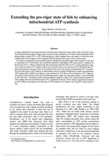Extending the pre-rigor state of fish by enhancing mitochondrial ATP synthesis
JIRCAS international symposium series
| ISSN | 13406108 |
|---|---|
| 書誌レコードID(総合目録DB) | AA1100908X |

本文フルテキスト
intlsymp-11_104-112.pdf334.75 KB
In Japan, spiked fish in a pre-rigor state have extremely high commercial value, similar to that of live fish. It has been claimed that the progress of rigor mortis is slower in carp acclimated to 10°C than in fish acclimated to 30°C during storage at either 0°C or I0°C. Wild specimens of plaice captured from cold waters in winter also show retarded rigor-mortis progress at 10°C compared with fish captured from warm water in other seasons.
Two factors are supposed to be associated with such temperature-dependent rigor-mortis progress in fish. One is intracellular Ca2+ concentration and myofibrillar adenosine triphosphate (ATP) consumption-enhanced by the increase of Ca2+, which is released from the sarcoplasmic reticulum (SR; the Ca2+-storing organelle in muscle) via nervous stimuli. Ca2+ uptake by SR is very low at 0°C due to a low activity of Ca2+-ATPase for the Ca2+ pump. Subsequently, fish rigor mortis is accelerated at 0°C due to the increase of intracellular Ca2+ concentration. The other factor is ATP synthesis in mitochondria. We have recently found that the content of mitochondrial ATP synthase (FoF1-ATPase) was higher in carp acclimated to 10°C than in fish acclimated to 30°C. Oligomycin-sensitive FoF1-ATPase activity per mitochondrial protein weight was three times higher in carp acclimated to 10°C than 30°C. Furthermore, plaice and red seabream adapted to about 10°C contained larger quantities of ATP synthase than fish acclimated to about 25°C, irrespective of species. These changes suggest that alterations in FoF1-ATPase, functioning at the final step of ATP production, are related to the progress of rigor mortis in
fish.
Two factors are supposed to be associated with such temperature-dependent rigor-mortis progress in fish. One is intracellular Ca2+ concentration and myofibrillar adenosine triphosphate (ATP) consumption-enhanced by the increase of Ca2+, which is released from the sarcoplasmic reticulum (SR; the Ca2+-storing organelle in muscle) via nervous stimuli. Ca2+ uptake by SR is very low at 0°C due to a low activity of Ca2+-ATPase for the Ca2+ pump. Subsequently, fish rigor mortis is accelerated at 0°C due to the increase of intracellular Ca2+ concentration. The other factor is ATP synthesis in mitochondria. We have recently found that the content of mitochondrial ATP synthase (FoF1-ATPase) was higher in carp acclimated to 10°C than in fish acclimated to 30°C. Oligomycin-sensitive FoF1-ATPase activity per mitochondrial protein weight was three times higher in carp acclimated to 10°C than 30°C. Furthermore, plaice and red seabream adapted to about 10°C contained larger quantities of ATP synthase than fish acclimated to about 25°C, irrespective of species. These changes suggest that alterations in FoF1-ATPase, functioning at the final step of ATP production, are related to the progress of rigor mortis in
fish.
| 作成者 | Shugo Watabe Shiro Itoi |
|---|---|
| 公開者 | Japan International Research Center for Agricultural Sciences |
| オンライン掲載日 | |
| 号 | 11 |
| 開始ページ | 104 |
| 終了ページ | 112 |
| 言語 | eng |
